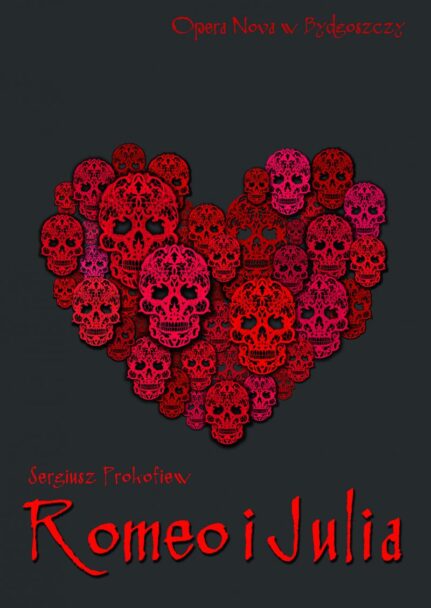
Graphic design: Diana Marszałek.
The 25th anniversary edition of the Bydgoszcz Opera Festival will be inaugurated with a premiere of Sergei Prokofiev?s ballet Romeo and Juliet performed by the Opera Nova orchestra and ballet company. The piece has not been staged at the Bydgoszcz opera for the past 30 years. The premiere will mark the third production Romeo and Juliet in Bydgoszcz after Rajmund Sobiesiak?s 1962 choreography and Przemysław Śliwa?s 1987 production. The latest interpretation has been developed by artists whose previous ballet premieres in Bydgoszcze include The Nutcracker or The Captive Mind. Romeo and Juliet will be choreographed by Paul Chalmer, an eminent dancer and choreographer, who transfers Shakespeare?s drama back into the Elizabethan age, assisted by Diana Marszałek?s buoyant stage design and Agata Uchman?s elaborate costumes. Musical direction has been assigned to Maciej Figas, who returns to Opera Nova with his second Prokofiev ballet, having previously acted as the musical director of Cinderella. The premiere performance of Romeo and Juliet will take place on 21 April 2018, followed by a repeat presentation on 22 April.
As of now, the artists are working separately: director Figas is working with the orchestra, assisted by Kamil Parcheta, while the ballet has been fine-tuning its sets supervised by Paul Chalmer and his assistant, Aurora Benelli. Paul Chalmer?s influences include two choreographic masters, John Cranko and George Balanchine, who taught him ?dance storytelling? in the neoclassical fashion. The role of Romeo was one of Chalmer?s most frequent stage creations throughout his dancing career. As choreographer, he staged Romeo and Juliet in 2013 at Conservatoire National Supérieur de Musique et de Danse in Paris.
Apart from Prokofiev?s music, the rehearsal room has been reverberating with the sound of swords and rapiers, produced by the fencing duels choreographed by Polish fencing champion Sylwester Zawadzki, a regular collaborator of Opera Nova. Similarly to ballet, fencing is an art whose internal parlance derives from the French language. Dancers study fundamentals of attacks, guards, and dodges, so that their duels appear as close to authentic as possible. Three casts of actors have been involved in the rehearsals.
The theatre?s sartorial workshops in the attic have been working at full tilt, turning silks, crepes, Jacquards, tulles, georgettes and velours ? brought in from the basements ? into sophisticated costumes. The fabrics have been provided by Polish and German wholesale contractors collaborating with major European theatres. Tailors? tables abound with designs and cuts, with manikins clad in working versions of the costumes (whose total projected number amounts to 200). 1000 running metres of fabric will be printed with a decorative pattern inspired by one of the Wawel Castle arrases. Dancers will also be wearing richly embroidered masks, dancing in the midst of an impressive setting comprised of a number of designs (as many as 6 in Act I alone) featuring hand-made metalwork.
About the Festival: http://www.opera.bydgoszcz.pl/XXV_Bydgoski_Festiwal_Operowy,30